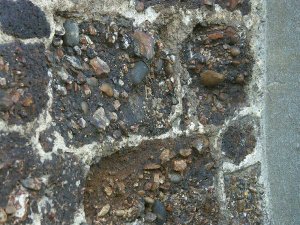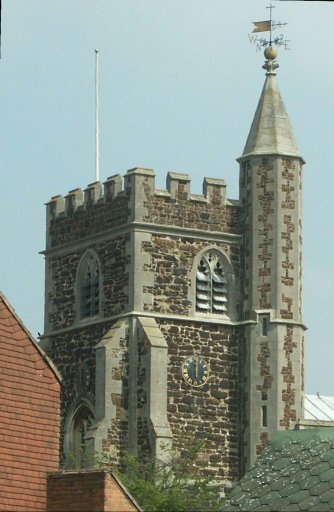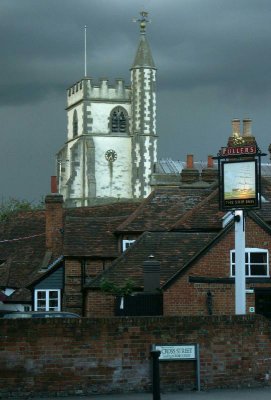
| Home page | Bellringing | Talks & lectures | Fell walking | Settle - Carlisle | Metal sculpture | Brickwork | Journeys | Ergonomics | The rest | Site map |
The bell tower at All Saints church in Wokingham was built around 1450. Bell towers are pretty durable but a lot can happen to the structure in over 650 years.
The Victorians extensively modified and repaired the church in the 19th century and their plans included ‘to heighten and restore the tower’. They proposed adding an extra 16 feet to the tower and moving the bells higher but they abandoned the idea, seemingly because the money ran out. That was just as well because they obviously didn’t understand the dynamics of a bell tower. All towers move a little when the bells are rung but it’s not normally noticeable. The higher the bells are in the tower the more it moves. All Saints tower is less strong than it would otherwise be because of the large West window and the open archway into the nave. It moves a little more than average but not unacceptably. That’s today, with the bells 5 feet lower than they were in 1860. Had the bells been moved 16 feet higher the increased movement would have made them extremely difficult to ring.

View through the base of the tower
Shortage of money in the 1860s also limited the repairs to the tower. It’s not clear exactly what was done but it seems the rendering was removed then – presumably because it was unsound – but not replaced, ‘hoping for more time before making the extra effort to complete that part of the work’. By 1875 both the inside and outside of the tower were in the headlines. Someone thought that the ‘unsightly gallery for the bellringers is a most serious blemish to the beauty of the Old Church’ but rather more seriously a piece of stone fell from the tracery of the West window, and more stone was loose.
Funds were still short so work was again delayed until enough money had been raised – a controversial decision, made more so when an anonymous letter to the Rector headed: ‘Let Wokingham take warning and exert itself’ told of a church tower near Brigend that had collapsed ‘destroying the south aisle and a harmonium, and disturbing several monuments’ because ‘the body of the church was restored ... but the tower was neglected for want of funds’.
Reluctantly the Restoration Committee authorised work ‘to secure the free stone from further accident’ but regretted spending money ‘for such a temporary purpose’. Fundraising efforts were increased – even the Queen contributed £50 – but the work dragged on until 1880.
The surveyors who reported on the structure in 1877 commented that restoration could be done ‘without altering in any way the appearance of this venerable and interesting tower’. That is interesting because removing the rendering in 1860 had drastically changed the tower’s appearance, with the rich brown puddingstone where previously there had been grey render.
Nervousness about the state of the tower reemerged in 1903 when the bells were augmented from 6 to 8. There was nothing wrong with the masonry but in their proposal for a new iron frame to fit in the extra bells, the bell hangers commented that the steel girders to support the frame would ‘strengthen the tower, as they would be tyes to the walls’. The mere mention of strengthening made some people worry that the tower was again unsafe.
What they should have worried about were the timber beams supporting the old bell frame, because ‘on taking off the floor, which was rotten, the beams were found to be in an advanced state of decay. In some cases the wood was eaten away, leaving only 4 or 5 inches of material, and that little better than tinder. In some cases the joints of the cross pieces had quite perished, so that these beams were only held in place by the floor boards’. So the augmentation project not only gave Wokingham more bells, it prevented a serious accident if the rotten beams had given way.

Close up of the puddingstone
The rendering removed in the 1860s was never replaced, and with the puddingstone exposed to the elements it began to erode. ‘Pebbles stuck together with rust’ is a pretty good description of puddingstone and over the next 150 years many pebbles fell off. In 2005 this was deemed unsafe and the exterior was renovated by re-rendering, but several tons of loose material had to be removed first before the new render could be applied.

Temporary protection against falling stones below the West window
The rendering was controversial because by then everyone had grown to love the sight of the rich brown tower, assuming it had always been like that. Proof that it hadn’t came when the clock faces were removed for renovation – behind them there were remains of the pre-1860 render.

The tower before restoration in 2005.

The tower after restoration in 2005
The hymn Abide with me says: ‘Change and decay in all around I see’. For the custodians of centuries old buildings, conservation and restoration are perennial tasks.
John Harrison, September 2016
| Back to Top | Back to Articles | Back to What's New | Return to Home page |